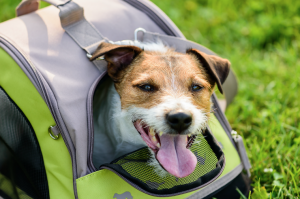For many, a family vacation just isn’t complete unless every member is present, and that certainly includes our pets. But when your vacation plans call for air travel, can you really trust the airline with the safety of your pet?
United’s latest streak of pet blunders, one of which ended in death, is almost habitual for the carrier. Of the 24 animal deaths reported to the D.O.T. last year, 18 occured on United Airlines. As for reported injuries, United claims 13 of 15 incidents that same year.
How to Keep Your Pet Safe During Air Travel
The truth is flying can still be really tough on pets. If you can get by with leaving your pet at home with a trusted sitter, do it. Otherwise, if the trip is an absolute necessity, there are things you can do to keep your pet safe and comfortable.
For starters, make sure your pet has a kennel that best suits its size. Airline rules generally state that a pet must be able to stand, turn around, and lie down. Kennel specifications will vary slightly between pets flying in cargo and those flying in the cabin, so check with your airline before purchasing. You’ll find some excellent kennels on Amazon, in durable plastic or soft-sided models. This Delta-branded Sherpa Deluxe is one of the more popular options for cabin-checked pets or, for cargo kennels, the Marchioro Clipper.
Considering how precious the cargo, it's unbelievable that a dog bound for Kansas City would wind up in Japan, but it happened. One way to prevent these incidents is by taping a polaroid of your pet to the kennel, with the name and breed written in Sharpie below. Yes, the airline does stick the same info on the kennel label, but the photo provides yet another way to easily identify your pet and, if it prevents anyone from accidentally winding up in Japan, seems worth the effort.
Airlines will require vaccination records and sometimes a letter from the vet stating that your pet is fit to fly. If anxiety is an issue, some veterinarians will prescribe a mild sedative like pet Xanax. When you can safely monitor your pet’s behavior in the cabin, anti-anxiety medication could be a great option. In cargo however, there’s no one to intervene in the off chance your pet reacts badly to the medication.
A DAP (dog appeasing pheromone) collar may be a safer alternative for calming stress-prone dogs.
It’s unlikely that your pet will escape its kennel, but there have been numerous stories throughout the years of cargo dogs doing just that. If you don’t already have your pet chipped, at least include your contact information on the pet’s collar.
We trust flight attendants to look out for our safety and assume they know best, but there are bad apples, obviously. Under FAA regulation, disobeying instructions from your flight crew is seen as interference in crew member duties, which could land you in cuffs. If a flight attendant orders you to do something that seems unreasonable or potentially harmful to your pet (such as, ahem, storing it in an overhead bin), try to involve additional crew members. Demand to speak to the captain, who can hopefully diffuse the situation before it goes off the rails.
If this doesn’t work, it may be best to disembark and ask to be put on another flight. That’s a huge inconvenience, but there are worse outcomes, as we saw earlier this week.
Above image by alexei_tm via Shutterstock






